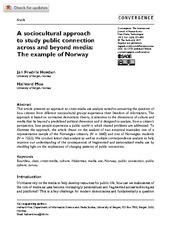A sociocultural approach to study public connection across and beyond media: The example of Norway
Peer reviewed, Journal article
Published version

Åpne
Permanent lenke
http://hdl.handle.net/1956/18414Utgivelsesdato
2017Metadata
Vis full innførselSamlinger
Originalversjon
https://doi.org/10.1177/1354856517700381Sammendrag
This article presents an approach to cross-media use analysis suited to answering the question of how citizens from different sociocultural groups experience their freedom of information. The approach is based on normative democratic theory, is attentive to the dimensions of culture and media that lie beyond a predefined political dimension and is designed to analyse, from a citizen’s perspective, how people experience a public world in which shared problems are addressed. To illustrate the approach, the article draws on the analysis of two empirical examples: one of a representative sample of the Norwegian citizenry (N = 3660) and one of Norwegian students (N = 1223). We conduct latent class analysis as well as multiple correspondence analysis to help improve our understanding of the consequences of fragmented and personalized media use by shedding light on the implications of changing patterns of public connection.
